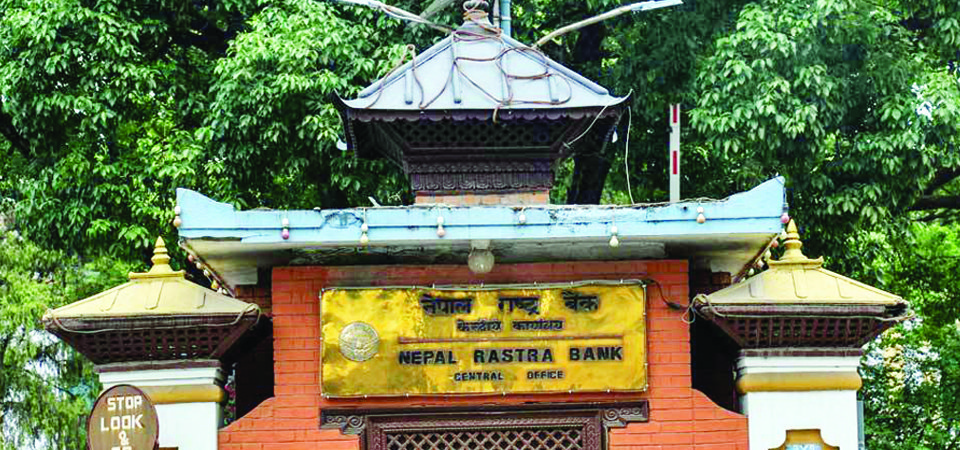Inflation up, foreign reserves down

By A Staff Reporter
Kathmandu, Feb. 10: Consumer price inflation has increased in the first three months of the current fiscal year 2021/22.
According to the current macroeconomic and financial report published by the Nepal Rastra Bank (NRB) on Wednesday, the year-on-year (y-o-y) consumer price inflation stood at 5.65 per cent in the sixth month of 2021/22 compared to 3.56 per cent a year ago.
Food and beverage inflation stood at 4.92 per cent whereas non-food and service inflation stood at 6.23 per cent in the review month.
The prices of ghee and oil, transportation, alcoholic drinks, tobacco products and pulses and legumes sub-categories rose by 21.22 per cent, 14.07 per cent, 11.37 per cent, 10.48 per cent and 9.22 per cent respectively on y-o-y basis.
In the review month, the Kathmandu Valley, Terai, Hill and Mountain witnessed 5.28 per cent, 6.15 per cent, 5.34 per cent and 5.22 per cent inflation respectively.
Inflation in these regions was 3.55 per cent, 2.87 per cent, 4.72 per cent and 3.38 per cent respectively a year ago.
The y-o-y wholesale price inflation stood at 8.08 per cent in the review month compared to 6.18 per cent a year ago.
The y-o-y wholesale price of consumption goods, intermediate goods and capital goods increased by 9.10 per cent, 7.67 per cent and 7.14 per cent respectively.
The y-o-y wholesale price of construction materials has increased by 17.51 per cent in the review month.
The y-o-y salary and wage rate index increased by 5.77 per cent in the review month. Such growth was 1.72 per cent a year ago. In the review period, salary index and wage rate index increased by 9.44 and 4.73 per cent respectively.
Remittance inflow lower by 5.5%
Meanwhile, the remittance inflows decreased by 5.5 per cent to Rs. 468.45 billion in the review period against an increase of 11.1 per cent in the same period of the previous year.
In the US dollar terms, remittance inflows decreased by 6.2 per cent to 3.93 billion in the review period against an increase of 6.7 per cent in the same period of the previous year.
Number of Nepali workers (institutional and individual-new and legalised) taking approval for foreign employment increased significantly to 167,513 in the review period.
It had decreased 89.0 per cent in the same period of the previous year. The number of Nepali workers (renew entry) taking approval for foreign employment increased by 298.1 per cent to 130,212 in the review period, said NRB.
It had decreased 75.5 per cent in the same period of the previous year.
Net transfer decreased by 4.9 per cent to Rs. 523.01 billion in the review period. Such transfer had increased by 8.9 per cent in the same period of the previous year.
BoP deficit up to Rs. 241.23 billion
Balance of Payments (BOP) remained at a deficit of Rs. 241.23 billion in the review period against a surplus of Rs. 124.92 billion in the same period of the previous year.
In the US dollar terms, the BOP remained at a deficit of 2.02 billion in the review period against a surplus of 1.05 billion in the same period of the previous year.
Similarly, the current account remained at a deficit of Rs. 354.07 billion in the first six months of the current fiscal year compared to a deficit of Rs. 51.68 billion in the same period of the previous year.
In the US dollar terms, the current account registered a deficit of 2.97 billion in the review period compared to deficit of 440.8 million in the same period last year.
In the review period, capital transfer decreased by 20 per cent to Rs. 5.48 billion while net foreign direct investment (FDI) increased by 48.1 per cent to Rs. 11.34 billion.
The capital transfer and net FDI amounted to Rs. 6.85 billion and Rs. 7.66 billion respectively in the same period of the previous year.
Foreign currency reserves downs by 16.7%
In the meantime, gross foreign exchange reserves decreased by 16.7 per cent to Rs. 1165.80 billion in mid-January 2022 from Rs. 1399.03 billion in mid-July 2021.
In the US dollar terms, the gross foreign exchange reserves decreased 15.9 per cent to 9.89 billion in mid-January 2022 from 11.75 billion in mid-July 2021.
Of the total foreign exchange reserves, reserves held by NRB decreased 18.4 per cent to Rs.1015.59 billion in mid-January 2022 from Rs. 1244.63 billion in mid-July 2021.
Reserves held by banks and financial institutions (except NRB) decreased by 2.7 per cent to Rs.150.21 billion in mid-January 2022 from Rs. 154.39 billion in mid-July 2021.
The share of Indian currency in total reserves stood at 24.5 per cent in mid-January 2022.
Based on the imports of six months of 2021/22, the foreign exchange reserves of the banking sector is sufficient to cover the prospective merchandise imports of 7.2 months, and merchandise and services imports of 6.6 months, said NRB.
The ratio of reserves-to-GDP (previous fiscal year), reserves-to-imports and reserves-to-M2 stood at 27.3 per cent, 54.8 per cent and 22 per cent respectively in mid-January 2022.
Such ratios were 32.8 per cent, 84.7 per cent and 27.1 per cent respectively in mid-July 2021.
Recent News

Do not make expressions casting dout on election: EC
14 Apr, 2022
CM Bhatta says may New Year 2079 BS inspire positive thinking
14 Apr, 2022
Three new cases, 44 recoveries in 24 hours
14 Apr, 2022
689 climbers of 84 teams so far acquire permits for climbing various peaks this spring season
14 Apr, 2022
How the rising cost of living crisis is impacting Nepal
14 Apr, 2022
US military confirms an interstellar meteor collided with Earth
14 Apr, 2022
Valneva Covid vaccine approved for use in UK
14 Apr, 2022
Chair Prachanda highlights need of unity among Maoist, Communist forces
14 Apr, 2022
Ranbir Kapoor and Alia Bhatt: Bollywood toasts star couple on wedding
14 Apr, 2022
President Bhandari confers decorations (Photo Feature)
14 Apr, 2022











